![[Previous]](prev.gif) |
![[Contents]](contents.gif) |
![[Index]](keyword_index.gif) |
![[Next]](next.gif) |
![[Previous]](prev.gif) |
![[Contents]](contents.gif) |
![[Index]](keyword_index.gif) |
![[Next]](next.gif) |
 |
This version of this document is no longer maintained. For the latest documentation, see http://www.qnx.com/developers/docs. |
In this chapter:
Before you begin the tutorials, we recommend that you first familiarize yourself with the IDE's components and interface by reading the IDE Concepts and Getting Started chapters.
You might also want to look at the core Eclipse basic tutorial on using the workbench in the Workbench User Guide (, then ).
 |
In earlier versions of the IDE, there were two different project types: Managed make, which automatically generated a makefile, and Standard make, which required a makefile to build. Now, you are required to select a project type, and that determines the build system to use. |
In this tutorial, you'll create a simple, C/C++ project (i.e. a project that doesn't involve the QNX recursive Makefile structure).
You use the New Project wizard whenever you create a new project in the IDE. Follow these steps to create a simple “hello world” project:
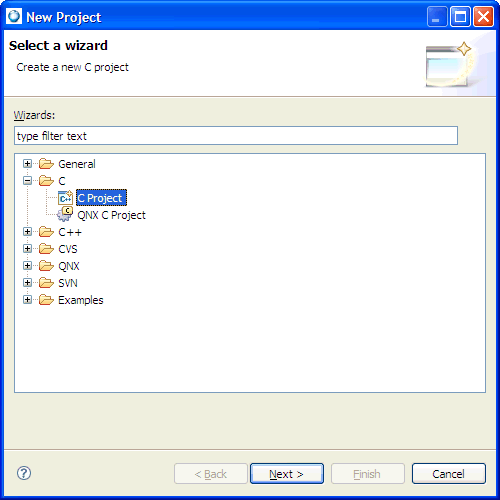
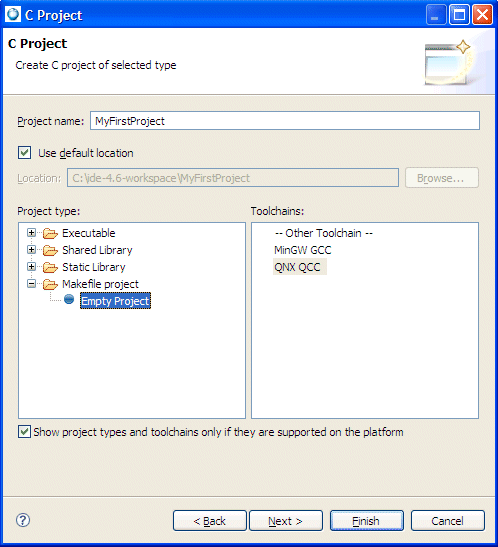
A toolchain represents the specific tools (such as a compiler, linker, and assembler) used to build your project. Additional tools, such as a debugger, can also be associated with a toolchain. Depending on the compilers installed on your system, there might be several toolchains available to select from.
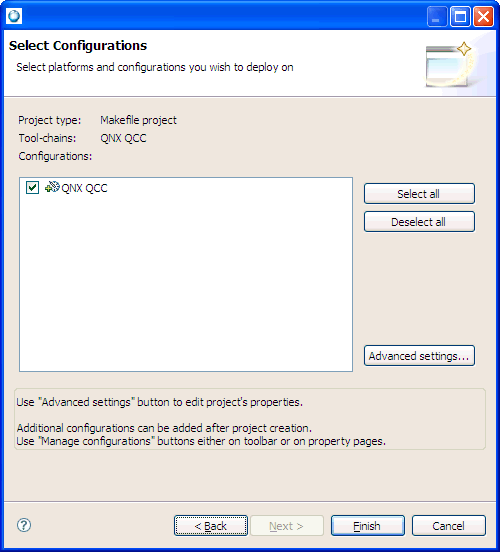
The fields for each panel are described in the “Project options” section, in the Wizards chapter.
To ensure the accuracy of the Project Explorer view and the ability to successfully run and debug your programs, it is important to select the correct parser. After you select the correct parser for your development environment and build your project, you can view the components of the .o file in the Project Explorer view. You can also view the contents of the .o file in the C/C++ editor.
The IDE creates your new project in your workspace. Your new project shows in the Project Explorer view, and in the Navigator view. If a message box prompts you to change perspectives, click Yes.
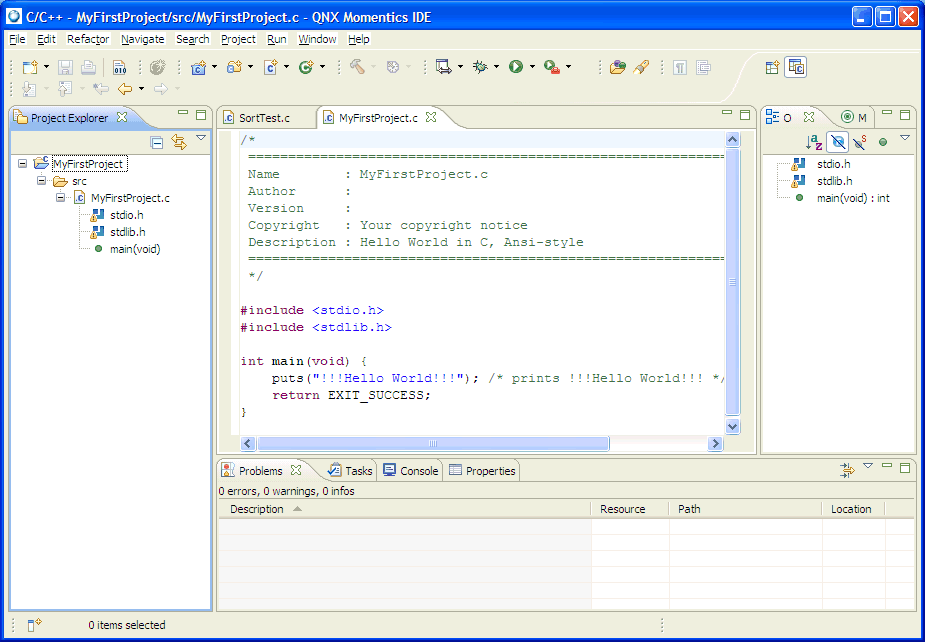
Now you'll create a Makefile for your project.
![]()
Here's a sample Makefile you can use:
CC:=qcc
all: hello
hello: hello.c
clean:
rm -f hello.o hello
 |
Use Tab characters to indent commands inside of Makefile rules, not spaces. |
#include <stdlib.h>
#include <stdio.h>
int main(int argc, char *argv[]) {
printf("Hello, world!\n");
return EXIT_SUCCESS;
}
Congratulations! You've just created your first Make C/C++ project in the IDE.
For instructions about building your program, see the section “Building projects” in the Developing C/C++ Programs chapter.
 |
In order to run your program, you must first set up a Neutrino target system. For details, see:
|
Unlike C/C++ projects, a QNX C/C++ project relies on the QNX recursive Makefile system to support multiple CPU targets. (For more information about the QNX recursive Makefile system, see the Conventions for Recursive Makefiles and Directories chapter in the Neutrino Programmer's Guide.)
Follow these steps to create a simple QNX C (or C++) “hello world” project:
The New Project wizard appears.
 |
Even though the wizard allows it, don't use any of the following characters in your project name (they'll cause problems later): | ! $ ( " ) & ` : ; \ ' * ? [ ] # ~ = % < > { } |
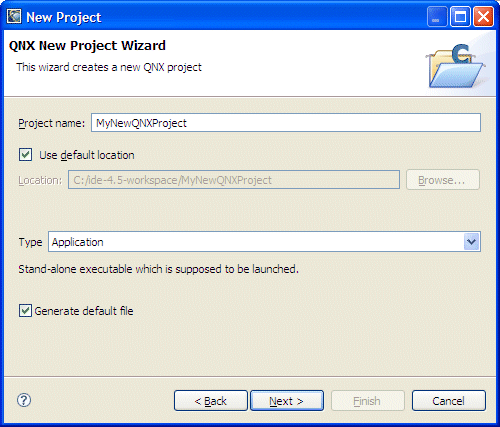
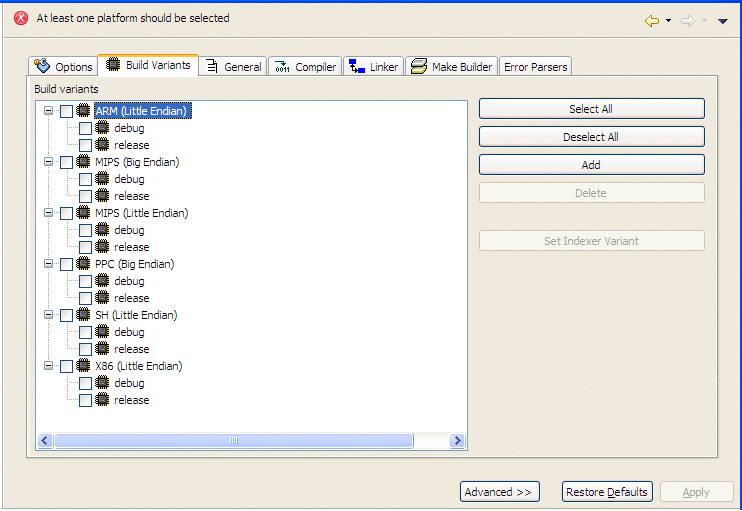
The IDE creates your QNX project and shows the source file in the editor.
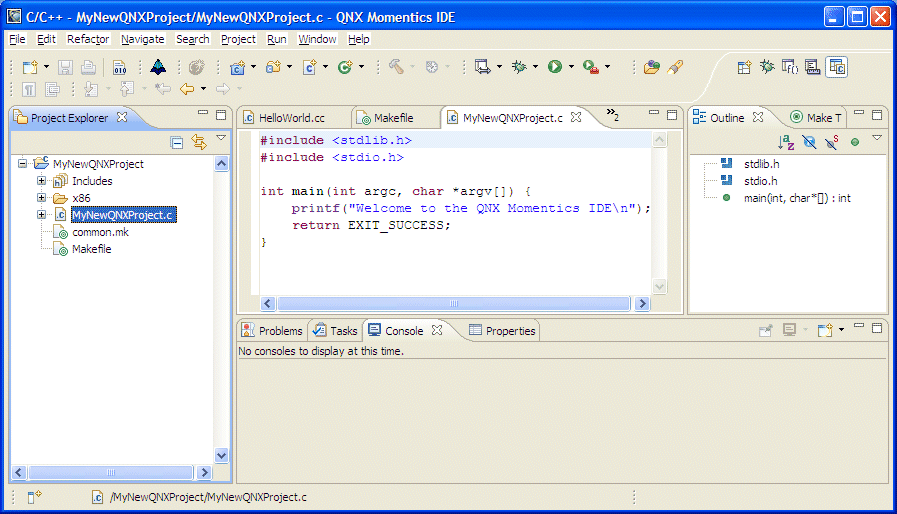
Congratulations! You've just created your first QNX project.
For instructions about building your program, see the section “Building projects” in the Developing C/C++ Programs chapter.
 |
In order to run your program, you must first set up a Neutrino target system. For details, see:
|
In this tutorial, you'll use the IDE's Import wizard, which lets you import existing projects, files, as well as files from ZIP archives into your workspace.
 |
You can use various methods to import source into the IDE. For details, see the Managing Source Code chapter. |
Follow these steps to bring one of your existing C or C++ projects into the IDE:
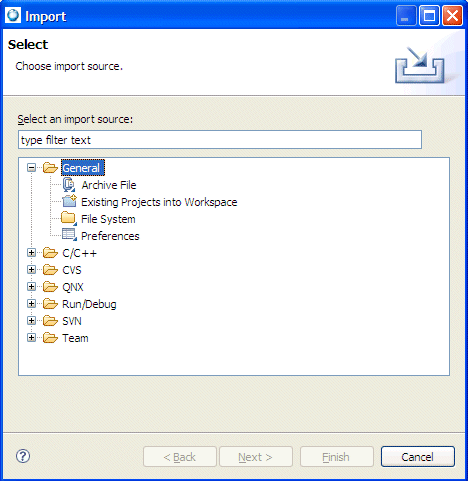
The IDE shows the Import Project From Filesystem panel.
Use the following buttons to help you make your selections:
Congratulations! You've just imported one of your existing projects into the IDE.
QNX BSPs and other source packages are distributed as .zip archives. The IDE lets you import both kinds of packages into the IDE:
| When you import: | The IDE creates a: |
|---|---|
| QNX source package and BSP | System Builder project |
| QNX C/C++ source package | C or C++ application or library project |
For more information on System Builder projects, see the Building OS and Flash Images chapter.
Congratulations! You've just imported a QNX BSP into the IDE.
![[Previous]](prev.gif) |
![[Contents]](contents.gif) |
![[Index]](keyword_index.gif) |
![[Next]](next.gif) |